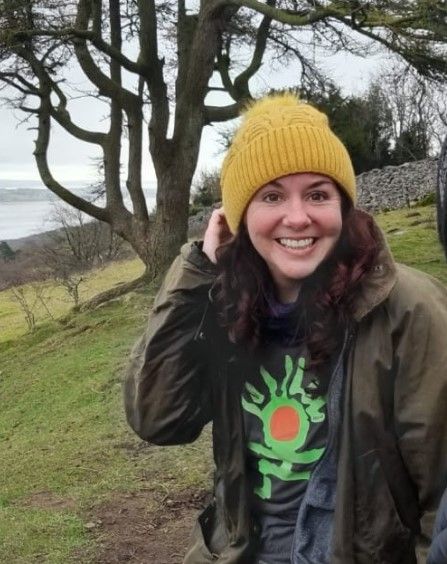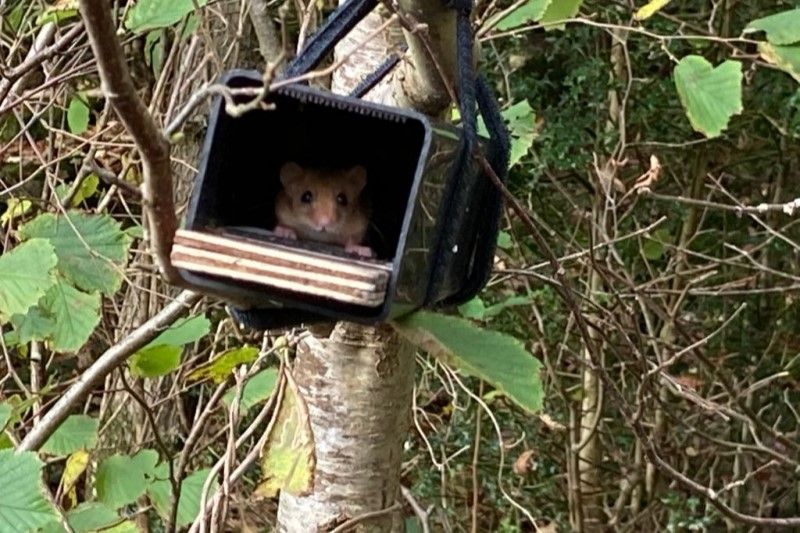Meet Tracy Cumberbatch: dormouse monitor
In this series, we chat to the dedicated staff members, conservation partners and volunteers at PTES. We find out why each of them chose a career in wildlife conservation, what they find rewarding about their work and what they love most about what they do.
Tracy Cumberbatch
Dormouse monitor in Lancashire
Tell us about yourself and the site you monitor
Hi, I’m Tracy and I am lucky enough to have the pleasure of monitoring dormice at Gait Barrows National Nature Reserve (NNR) in Lancashire. Gait Barrows was chosen as a dormouse reintroduction site in the summer of 2021, just 10 months into my new job with Natural England as a Reserve Warden.
Prior to me working in this role, I was a self-employed dry stone waller and had longed for some time to gain a job in practical conservation. From day one, my dream job exceeded all my expectations, and just when I thought it couldn’t possibly get any better, we welcomed the arrival of 30 dormice back into the local landscape.
As part of a multi-partnership project, I assisted in that first survey season where I was lucky to get some hands-on experience in addition to a very interesting and useful trip to the Isle of Wight where I gained further handling knowledge and experience from Ian White of PTES.
We are very lucky to have a very keen, enthusiastic and committed army of volunteers who come out to the reserve every month to joyfully assist us with our regular nest box and footprint tunnel checks – without whom we wouldn’t be able to do this important work.
What’s the most memorable day you’ve had looking for dormice?
This is such a difficult question, because truly every day I’ve spent looking for dormice has been very special for a variety of reasons. The very fact that we’re able to find dormice at all is something that I do not take for granted. To have redressed some ecological balance through this reintroduction is something very special in itself – in a world of ecological decline, it’s heartening to be part of something positive and valuable.
However, there is a particular day that stands out as being very special. I was out with a great team of volunteers on a footprint tunnel check – I had put some up in an area where I did not expect to find any evidence of dormouse activity, as I deemed it to be too far away from the release site – when lo and behold, we found not footprints, but a gorgeous adult dormouse in a nest in the footprint tunnel. It peered its fluffy head out of one end much to our surprise and amazement!
Describe your woodland and why is it special to you?
Gait Barrows NNR contains a rich mosaic of habitats from limestone pavement, species rich grassland, wetland, peatland and of course woodland including coppiced hazel. The woodland is special to me because of the underlying geology – there is something other-worldly about seeing pockets of the woodland floor cloaked in a carpet of moss over limestone pavement. There are some really magnificent tree specimens and the woodland supports a range of invertebrates, some of which are nationally scarce.
What are the challenges at the site?
Recreational disturbance is one of the biggest challenges. The reserve is a popular place for people exercising their dogs, and we have dog-free zones which sadly aren’t always adhered to. However, since the reintroduction of dormice, the rationale for this zonation has often been easier to express to some people. Unsurprisingly, the cuteness of a fluffy little dormouse tends to win people over more than a rare moss or insect, so having dormice as a flagship species to win over people’s hearts and minds is a good way to engage people on the importance of keeping disturbance to a minimum for the benefit of a range of plant and animal species.
Managing the woodlands for a variety of different species which have differing requirements can also present challenges, but this can largely be overcome through careful planning.
Tell us something about you we wouldn’t expect from a dormouse monitor
I used to teach aerobics and Zumba. I still love dancing now and once I’m on a dancefloor, it’s difficult to get me off it (as my friends will attest)!
Can you help us reintroduce more dormice to the wild?
Header image credit Miroslav Hlavko | Shutterstock.com


